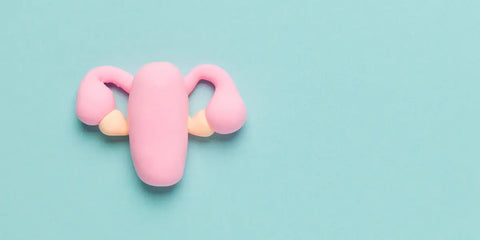Endometriosis is one of the most common health problems among women and a leading cause of infertility . What is its frequency? It is estimated that more than 190 million women worldwide suffer from symptoms of endometriosis.
Treatments for endometriosis exist
If you suffer from pain and discomfort in your pelvic area, endometriosis may be the cause. The good news is that there are endometriosis treatment options to deal with this uncomfortable condition.
Due to the large number of treatment options and the fact that every woman responds differently to medications and supplements, treating endometriosis often requires a period of experimentation . Education is key – you know your body better than anyone, so familiarize yourself with the root causes and treatments (conventional and natural) before opting for a more radical surgical procedure.
Learn what exactly endometriosis is, why endometriosis symptoms appear, and how you can treat them.
What is endometriosis?
Endometriosis is a disease in which tissue , similar to the lining of the uterus, grows in other parts of the body . The female reproductive system includes the vagina, uterus, fallopian tubes and ovaries.
During a normal menstrual cycle , the ovaries produce hormones that cause the uterine lining to thicken . This is the endometrium, the inner lining of the uterus. The endometrium grows to prepare to receive a fertilized egg. If the egg is never fertilized, it leads to menstruation, or shedding of the lining.
A uterine lining outside the uterus
In people with endometriosis, the lining grows outside the uterus . The misplaced tissue responds to hormones by thickening and shedding with each menstrual cycle. However, the thick tissue is outside the uterus and is not able to pass through the vagina and out of the body. Endometrial flow is then trapped and can cause inflammation and pain . Adhesions, or scar tissue, can form and stick from one organ to another. The fallopian tubes may even close, which is a dangerous symptom of endometriosis because it can lead to infertility .

Cyst formation
Another frightening symptom of endometriosis is the formation of endometriomas - known as dark, red-brown cysts or fluid-filled pockets on the ovaries , which affect fertility. Endometriosis can also lead to abnormal bleeding .
Studies have shown that 40 to 60% of women who have very painful periods also suffer from endometriosis, and that 20 to 30% of women who are unable to get pregnant may have this condition. It helps to listen to your body and know the common symptoms of endometriosis.
There is currently no cure for endometriosis, but various treatments are used to relieve symptoms . Some medication options, such as hormone therapy, may increase the risk of long-term infertility and cancer. If endometriosis symptoms become too severe, surgical procedures may even be necessary.
Fortunately, there are natural remedies for endometriosis that can be used before resorting to hormonal treatments or invasive surgical procedures.
Symptoms
Since 2-50% of women are thought to have "silent" endometriosis, meaning they have only subtle or no clinical symptoms, it is important to know the symptoms of endometriosis . Endometrial tissue, or implants, can grow outside the uterus or in the lining of a fallopian tube.
The disease often affects the ovaries, the ' Douglas sac ' - which lies between the uterus and rectum at the end of the intestine - and the connective tissue in this area. It is when the ovaries or fallopian tubes are affected that women experience fertility problems.
Common symptoms of endometriosis include:
- painful (also called dysmenorrhea) or irregular periods
- painful intercourse
- increased pain during bowel movements
- increased pain during urination
- excessive bleeding
- spotting and bleeding between cycles
- painful digestion
- constipation
- nausea
- chronic pain in the lower back and abdomen
- pelvic pain
- infertility
- articular pain
- nerve pain
- chronic fatigue
- bloating
In many women, the progression of endometriosis symptoms is slow and takes place over several years. Every woman experiences different pain, which can make diagnosis difficult. The pain usually begins in the lower abdomen and worsens during menstruation or sexual intercourse. As the pain intensifies, it may begin to radiate into the lower abdomen, back and legs – it is often described as a cramp-like pain.

Causes of endometriosis
The root cause of endometriosis is unclear, but there appears to be a strong genetic link within families. It is accepted that endometriosis is not contagious and therefore cannot be transmitted through sexual intercourse .
Endometriosis affects women of childbearing age. It is estimated that 20 to 50% of women treated for infertility suffer from endometriosis. Having your period early in life, delaying pregnancy until old age, never giving birth, and going through menopause later in life can also increase the risk of endometriosis.
There are other theories about the causes of endometriosis. One is that menstrual flow is backed up into the fallopian tubes and into the pelvic and abdominal cavity during menstruation, causing endometrial tissue to grow outside the uterus .
Another possibility is coelomic metaplasia - when the areas lining the pelvic organs contain primitive cells that can develop into other forms of tissue, such as endometrial cells.
Interaction between a woman's hormones and her immune system .
Direct transfer of endometrial tissue during surgical procedures may also explain the symptoms of endometriosis. Cells can be transferred through the bloodstream or lymphatic system during surgical procedures, such as a cesarean section or episiotomy. The scar tissue may also contain endometrial cells which will then grow outside the uterus.
A final explanation is that there is a problem with the interaction between a woman's hormones and her immune system . Our immune system is supposed to ensure that tissue from a particular organ does not grow elsewhere in the body, and is therefore the one that is blamed for allowing endometrial tissue to grow outside the body. uterus.
Conventional treatments
Unfortunately, conventional treatments for endometriosis may require a period of experimentation to find what works. Pain relievers are usually prescribed to treat the pain, but not the underlying problem. Hormonal treatments, such as hormonal contraception or hormonal therapy, are a common route taken by doctors. They regulate hormones, slow the growth of endometrial implants and reduce menstrual flow.
The most common conventional treatments are:
Drugs
1. Lupron
Lupron is an injection used to induce hormonal and menstrual suppression in patients with endometriosis, resulting in less pain symptoms. The most common side effects are a drop in blood pressure, redness, pain and burning at the injection site, fatigue, headache, stomach pain and muscle pain.
2. Progestins
Progestin is a medication that behaves like the female hormone progesterone. Progestins work by suppressing the growth of endometrial impacts and reducing endometriosis-induced inflammation in the pelvic cavity.
During treatment, women lose their periods and their ability to conceive. Women who have received long-acting injections may experience prolonged delays in the return of periods after treatment.
Like all hormonal medications, they have common side effects, including acne, bloating, bleeding, breast discomfort, depression, fatigue, headache, stomach upset, nausea, vomiting and weight gain. These side effects can be difficult to live with and some women cannot complete treatment because they find them intolerable.
3. Danazole
Danazol is a synthetic steroid that acts as a mild androgen (hormones produced by the male testes), but does not have estrogenic or progestogenic properties. Androgens are responsible for the functioning of the male reproductive system and the development of male characteristics, such as facial hair and a deep voice.
Danazol is used to suppress the growth and development of endometrial tissue. The hormonal environment caused by danazol also stops menstruation. Because it serves as a synthetic male hormone, danazol has androgenic side effects, such as weight gain, increased body hair and acne, decreased breast size, deepening of voice, water retention and oily skin or hair.
Surgical procedures
1. Laparoscopic excision or ablation surgery
Laparoscopic surgery is the most common procedure used by doctors for the treatment of endometriosis. The surgeon makes a small incision to insert a lighted observation instrument called a laparoscope. This instrument allows the surgeon to view the internal organs to look for signs of endometriosis and remove visible endometriosis implants and scar tissue that may be causing pain or infertility. If a cyst is discovered, it is also removed.
During the procedure, the patient's abdomen is inflated with gas, which pushes the abdominal wall away from the organs so the surgeon can see clearly. Scar tissue or implants are removed by cutting them (excision) or destroying them using a laser beam or electric current (ablation). Ablation is generally used for very small lesions, with excision being the preferred technique for large lesions because it carries fewer risks.
Risks of laparoscopic surgery include pelvic infections, uncontrolled bleeding, scar tissue formation, and damage to the bowel, bladder, or ureters.
2. Hysterectomy
Hysterectomy is the surgical removal of the uterus through the abdominal wall or vagina. A total hysterectomy involves removing the entire uterus, including the body of the uterus and the cervix. A subtotal hysterectomy involves removing the uterus but not the cervix. Other organs may also be removed during a hysterectomy, including the ovaries and fallopian tubes.
A hysterectomy is not guaranteed to relieve all symptoms of endometriosis, as there may be some endometrial tissue left in the body after the uterus is removed. According to a 2014 review published in Facts, Views & Vision in ObGyn , a high recurrence rate of 62% was reported in advanced stages of endometriosis where the ovaries were retained. Based on the 77 articles identified for the review, incomplete excision of endometriosis is the most common reason in the literature for recurrence of endometriosis symptoms.
Does endometriosis increase the risk of cancer?
Research suggests that women with endometriosis have a higher risk of developing ovarian, breast, or endometrial cancer . According to a study published in Obstetrics and Gynecology , the incidence of endometrial cancer has increased by 21% since 2008, and the mortality rate has increased by more than 100% over the past two decades.
Endometrial, ovarian, and breast cancers are associated with several risk factors, such as low parity, infertility, early menstruation, and late menopausal symptoms.

Potential risk of increased cancer
A scientific review conducted in Italy investigated the possible role of endometriosis and infertility in increasing cancer risk . Many studies have shown that women suffering from infertility may be at greater risk of endometrial cancer, particularly if they suffer from ovulation disorders . Additionally, infertility and endometriosis today are often treated with medical devices that could single-handedly alter the hormonal environment of a woman's body and serve as cofactors in cellular changes leading to to the development of cancer.
But no specific risk identified
The researchers conclude that there are no definitive answers about the precise effects of infertility and endometriosis and their treatments on cancer risk, but that other studies involving participants subjected to drug treatments fertility and treatment of ovulation disorders are required.
Another study published in the American Journal of Obstetrics and Gynecology followed the records of 20,686 women hospitalized for endometriosis from 1969 to 1983 and the Swedish National Cancer Registry through 1989 to identify subsequent cancer diagnoses . 55% of these women have undergone gynecological operations following a diagnosis of endometriosis.
After following these subjects for more than 11 years, significant excess cancer risks were observed for breast cancer , ovarian cancer , and hematopoietic malignancies. The risk of ovarian cancer was particularly high in subjects with a long-standing history of ovarian endometriosis . The researchers suggest that, based on these findings, more attention should be paid to the risk of breast, ovarian, and hematopoietic cancer in women with endometriosis and the hormonal and immunological reasons should be explored. possible of this excess risk.
First action: vigilance
Due to this increased risk of cancer, highlighted by several studies, women with endometriosis must be more vigilant. Be sure to get cancer screening exams , such as mammograms. Listen to your body and the early signs of ovarian cancer, such as bloating, pelvic or abdominal pain, difficulty eating, and a frequent need to urinate. Discuss the increased risk of cancer with your doctor and implement a prevention plan, such as reducing stress , eating a healthy, anti-inflammatory diet , and exercising .

Natural Ways to Relieve Symptoms
1. Healthy diet
To relieve endometriosis symptoms naturally , start by eliminating foods that promote inflammation . These include dairy , processed foods, refined sugars , caffeine , and carbohydrates .
Eliminate these foods from your diet for at least three weeks , paying close attention to how your body changes throughout the process. Alcohol, soy, and other high estrogen foods should also be eliminated from your diet due to their estrogenic effects.
According to a study published in Reproductive Biomedicine Online , women with endometriosis appear to consume few vegetables and omega-3 fatty acids and more red meat, coffee and trans fats. Allergy testing can also be helpful in determining which foods are causing inflammation in the body.
It is important to follow an anti-inflammatory diet when you have endometriosis. A 2004 study published in the journal Human Reproduction found a significant reduction in the risk of developing endometriosis in women who consumed fresh green vegetables and fruits.
This means it is good to consume these very beneficial anti-inflammatory foods, such as green leafy vegetables , celery , beets , blueberries, salmon, bone broth, nuts, flax seeds and many others.
Foods rich in magnesium also help soothe the uterus and reduce pain. These include pumpkin seeds, sunflower seeds, black beans, avocado, almonds, bananas, chard and spinach.
Foods rich in iron are also important because they compensate for the loss of iron in the body that results from excessive bleeding. Iron-containing foods include liver, beef steak, white beans, black beans, spinach, egg yolk, prunes, artichokes and cabbage leaves.

Additionally, omega-3 foods help reduce inflammation , relieve joint and muscle pain, and regulate hormone production. Add flax seeds, chia seeds, walnuts, salmon, trout, tuna, sardines, anchovies and mackerel to your diet.
If constipation is a symptom of endometriosis, eat high-fiber foods like quinoa, vegetables, brown rice, berries, coconut, figs, artichokes, peas, okra, sprouts from Brussels, turnips and squash.
2. Supplements
Certain supplements can be beneficial for people suffering from endometriosis, such as fish oil, meadowsweet, milk thistle, or even Ayurvedic plants such as ashwagandha or horse chestnut which have been subject of several scientific studies.
You can also take 50 milligrams of vitamin B complex daily to balance hormone levels. B vitamins benefit general health and reduce toxicity in the body , supporting cellular function. They also regulate and balance the body's organs and promote healthy immunity. Vitamin B6 , for example, relieves chronic pain, boosts mood and increases energy levels.
3. Acupuncture
A study conducted at Harvard Medical School showed that Japanese-style acupuncture may be an effective, safe, and well-tolerated adjunctive treatment for pelvic pain related to endometriosis.
The study included 18 young women aged 12 to 22 suffering from chronic pelvic pain related to endometriosis and diagnosed by laparoscopy. Participants in the active acupuncture group experienced 62% less pain after four weeks, which differed significantly from the control group's average reduction.
4. Essential oils
Castor oil can be used to boost immune function and soothe digestion , and castor oil compresses can be used on the lower abdomen and pelvic area to reduce pain and inflammation.
Additionally, clary sage helps naturally balance hormones and has been shown to reduce pain and cramping when applied topically. Apply two to four drops topically to the abdomen, then apply a warm compress to the area to relieve pain.
Final Thoughts
The symptoms of endometriosis unfortunately affect a large number of women of childbearing age , but there are measures to prevent and treat this disease. The first step is to know and identify the symptoms in order to find the appropriate treatment methods.
If you follow an anti-inflammatory diet and consume beneficial supplements, you can curb endometriosis – as is the case with most conditions. Also, acupuncture and essentials can work wonders. By combining these four natural remedies, you can avoid unnecessary and dangerous surgery.
Although there is no cure, if you follow these steps, you can manage, treat, and even prevent the symptoms of endometriosis from becoming a major hindrance in your life.







